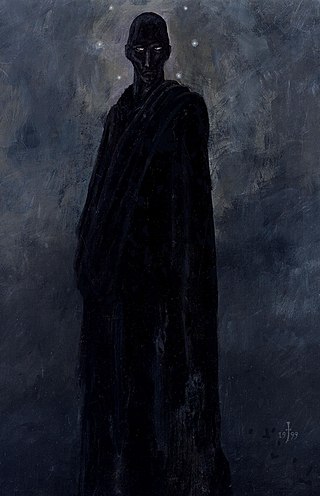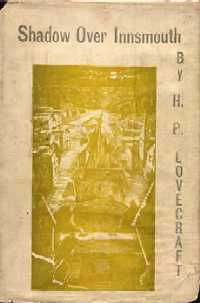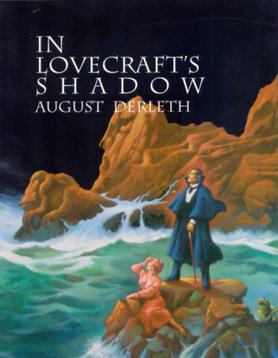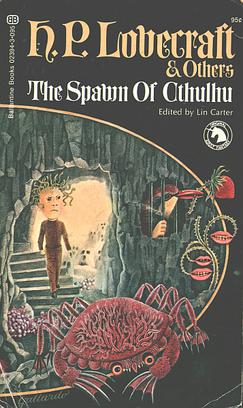
Shub-Niggurath is a deity created by H. P. Lovecraft. She is often associated with the phrase "The Black Goat of the Woods with a Thousand Young". The only other name by which Lovecraft referred to her was "Lord of the Wood" in his story The Whisperer in Darkness.

Nyarlathotep is a fictional character created by H. P. Lovecraft. The character is a malign deity in the Cthulhu Mythos, a shared universe. First appearing in Lovecraft's 1920 prose poem "Nyarlathotep", he was later mentioned in other works by Lovecraft and by other writers. Later, writers describe him as one of the Outer Gods, an alien pantheon.

Ramsey Campbell is an English horror fiction writer, editor and critic who has been writing for well over fifty years. He is the author of over 30 novels and hundreds of short stories, many of them winners of literary awards. Three of his novels have been adapted into films.

Azathoth is a deity in the Cthulhu Mythos and Dream Cycle stories of writer H. P. Lovecraft and other authors. He is the supreme deity of the Cthulu Mythos and the ruler of the Outer Gods, and may also be seen as a symbol for primordial chaos, therefore being the most powerful entity in the entirety of the Cthulhu Mythos.

Robert William Chambers was an American artist and fiction writer, best known for his book of short stories titled The King in Yellow, published in 1895.

Hastur is an entity of the Cthulhu Mythos.
Carcosa is a fictional city in Ambrose Bierce's short story "An Inhabitant of Carcosa" (1886). The ancient and mysterious city is barely described and is viewed only in hindsight by a character who once lived there.

The Shadow over Innsmouth is a horror novella by American author H. P. Lovecraft, written in November–December 1931. It forms part of the Cthulhu Mythos, using its motif of a malign undersea civilization, and references several shared elements of the Mythos, including place-names, mythical creatures, and invocations. The Shadow over Innsmouth is the only Lovecraft story that was published in book form during his lifetime.

Lovecraftian horror, also called cosmic horror or eldritch horror, is a subgenre of horror fiction and weird fiction that emphasizes the horror of the unknowable and incomprehensible more than gore or other elements of shock. It is named after American author H. P. Lovecraft (1890–1937). His work emphasizes themes of cosmic dread, forbidden and dangerous knowledge, madness, non-human influences on humanity, religion and superstition, fate and inevitability, and the risks associated with scientific discoveries, which are now associated with Lovecraftian horror as a subgenre. The cosmic themes of Lovecraftian horror can also be found in other media, notably horror films, horror games, and comics.

The Whisperer in Darkness is a 26,000-word novella by American writer H. P. Lovecraft. Written February–September 1930, it was first published in Weird Tales, August 1931. Similar to The Colour Out of Space (1927), it is a blend of horror and science fiction. Although it makes numerous references to the Cthulhu Mythos, the story is not a central part of the mythos, but reflects a shift in Lovecraft's writing at this time towards science fiction. The story also introduces the Mi-Go, an extraterrestrial race of fungoid creatures.
A Cthulhu Mythos anthology is a type of short story collection that contains stories written in, or related to, the Cthulhu Mythos genre of horror fiction launched by H. P. Lovecraft. Such anthologies have helped to define and popularize the genre.

The Three Impostors; or, The Transmutations is an episodic horror novel by British writer Arthur Machen, first published in 1895 in The Bodley Head's Keynotes Series. It was revived in paperback by Ballantine Books as the forty-eighth volume of the Ballantine Adult Fantasy series in June 1972.

The Mask of Cthulhu is a collection of fantasy and horror short stories by American writer August Derleth. It was released in 1958 by Arkham House in an edition of 2,051 copies.

In Lovecraft's Shadow: The Cthulhu Mythos Stories of August Derleth is a collection of fantasy and horror short stories by American writer August Derleth. It was released in 1998 by Mycroft & Moran in an edition of 2,051 copies.

The Spawn of Cthulhu is an anthology of fantasy short stories, edited by American writer Lin Carter. It was first published in paperback by Ballantine Books in October 1971 as the thirty-sixth volume of its Ballantine Adult Fantasy series. It was the fifth anthology assembled by Carter for the series.
"I, Cthulhu" is a short humorous story by fantasy author Neil Gaiman featuring H. P. Lovecraft's Cthulhu, who is dictating an autobiography to a human slave named Whateley. The story reveals much about Cthulhu's 'birth' and early life.

Joseph S. Pulver Sr. was an author and poet, much of whose work falls within the horror fiction, noir fiction / hardboiled, and dark fantasy genres. He lived in Germany, and died from COPD and other issues in a German hospital on April 24, 2020.
Lynda Rucker is an author of horror and fantasy short stories.
Bibliography of science fiction, fantasy, and nonfiction writer Lin Carter:
















